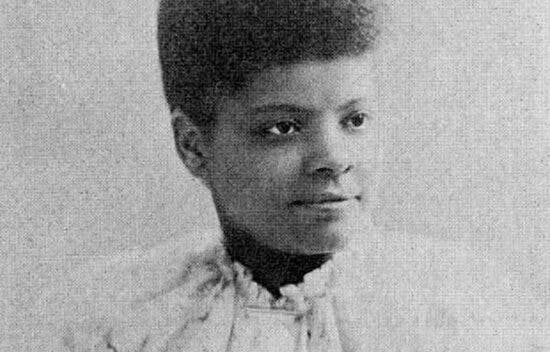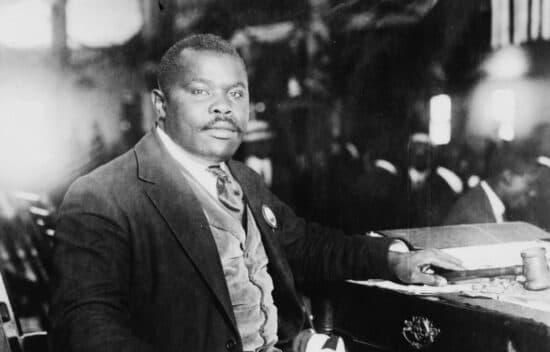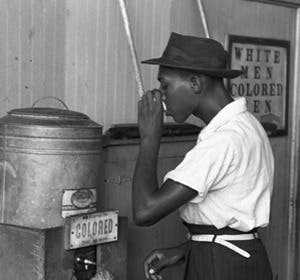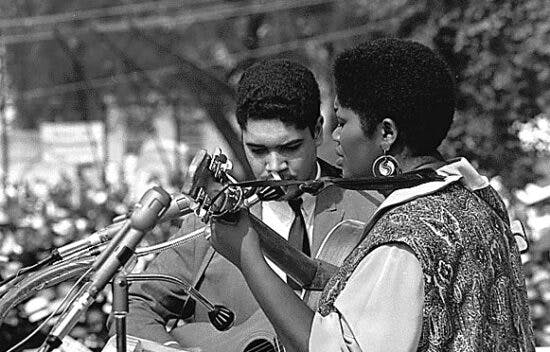



Black History Month
23 items

The Plainest Demands of Justice
Page
Page
Through primary source analysis, this new resource from the Bill of Rights Institute explores the efforts to realize the Founding principles of liberty, equality, and justice by exploring key periods in African American history. Students of history know that there is no substitute for being there – but primary sources come close! For over twenty […]

Frederick Douglass and Identity: Resurrection to the Heaven of Freedom
Lesson - 2 Activities
Lesson
2 Activities
45 Min
Examine key events in the life of Frederick Douglass and the turning point when he determined not to remain a slave.
45 Min

Harriet Tubman: Follow the North Star to Freedom
Lesson - 1 Activities
Lesson
1 Activities
45 Min
How did Harriet Tubman act responsibly by helping many people escape slavery?
45 Min

African Americans in the Gilded Age
Lesson - 12 Activities
Lesson
12 Activities
120 Min
Constitutional amendments were ratified during and after the Civil War to protect the natural and civil rights of African Americans. Despite these legal protections, the condition of African Americans significantly worsened in the last few decades of the nineteenth century. In the late nineteenth century, the promise of emancipation and Reconstruction went largely unfulfilled and was even reversed in the lives of African Americans. Southern blacks suffered from horrific violence, political disfranchisement, economic discrimination, and legal segregation. Ironically, the new wave of racial discrimination that was introduced was part of an attempt to bring harmony between the races and order to American society.
120 Min

Taking Responsibility: Ida B. Wells and the Anti-Lynching Campaign
Lesson - 1 Activities
Lesson
1 Activities
45 Min
How did Ida B. Wells’ anti-lynching campaign and her teaching of others about lynching show responsibility?
45 Min

To Accomplish the Most Good: Booker T. Washington’s Education
Lesson - 1 Activities
Lesson
1 Activities
45 Min
In this lesson, students will read about and discuss how Booker T. Washington remained diligent about obtaining an education. They will draft an illustrated “map” of Booker T. Washington’s journey toward an education, and they will discuss how they can be diligent in their own lives.
45 Min

Debating Strategies for Change: Booker T. Washington vs. W.E.B. Du Bois
Lesson - 2 Activities
Lesson
2 Activities
65 Min
Use this Lesson with the Booker T. Washington, "Speech to the Cotton States and International Exposition," 1895 Primary Source to allow students to analyze and compare arguments for the early African American civil rights movement.
65 Min

Marcus Garvey, “Declaration of the Rights of the Negro Peoples of the World,” 1920
Activity
Activity
40 Min
Use this primary source text to explore key historical events.

Langston Hughes, “I, Too” and “The Weary Blues,” 1920 and 1925
Activity
Activity
40 Min
Use this primary source text to explore key historical events.

That Golden Moment: Jesse Owens and Identity
Lesson - 1 Activities
Lesson
1 Activities
45 Min
How can Jesse Owens' identity inspire students to advance freedom in their own lives?
45 Min

The Tuskegee Airmen: Defending and Improving the United States
Lesson - 1 Activities
Lesson
1 Activities
45 Min
In this lesson, students will learn about the actions of the Tuskegee Airmen and how they helped African-Americans gain respect. They will explore how they can be respectful in their own lives.
45 Min

Number 42: Jackie Robinson and Courage
Lesson - 1 Activities
Lesson
1 Activities
45 Min
How did Jackie Robinson, who persevered through the integration of major league baseball, display courage? Students will see how they can courageously fight for equality in their own lives.
45 Min

Elizabeth Eckford, the Little Rock Nine, and Purpose
Lesson - 1 Activities
Lesson
1 Activities
45 Min
What about Elizabeth Eckford and the other 'Little Rock Nine' drove them to help advance freedom and equality?
45 Min

Black Power
Essay - 2570 Words
Essay
2570 Words
Explores the impact of the Black Power movement in the 1960s.

Rosa Parks, the Montgomery Bus Boycott, and Purpose
Lesson - 1 Activities
Lesson
1 Activities
45 Min
What about Rosa Parks’ purpose lead her to participate in the Montgomery Bus Boycott?
45 Min

I Have a Dream: Martin Luther King, Jr. and Identity
Lesson - 1 Activities
Lesson
1 Activities
45 Min
How did Martin Luther King, Jr., contribute to American identity?
45 Min

Essay: The Civil Rights Movement
Essay - 2314 Words
Essay
2314 Words
The Civil Rights Movement sought to win the American promise of liberty and equality during twentieth-century America. From the early struggles of the 1940s to the crowning successes of the Civil Rights and Voting Rights Acts that changed the legal status of African-Americans in the United States, the Civil Rights Movement firmly grounded its appeals for liberty and equality in the Constitution and Declaration of Independence. Rather than rejecting an America that discriminated against a particular race, the movement fought for America to fulfill its own universal promise that "all men are created equal." It worked for American principles within American institutions rather than against them.

The Music of the Civil Rights Movement
Lesson
Lesson
Use this lesson with the Freedom Riders Narrative; The March on Birmingham Narrative; the Black Power Narrative; the Martin Luther King Jr., "Letter from Birmingham Jail," 1963 Primary Source; the Martin Luther King Jr., "I Have a Dream," August 28, 1963 Primary Source; the Civil Disobedience across Time Lesson; and the Civil Rights DBQ Lesson to discuss the different aspects of the civil rights movement during the 1960s.

A Self-Made Man: The Story of Thurgood Marshall
Lesson - 1 Activities
Lesson
1 Activities
45 Min
How can the accomplishments of Thurgood Marshall help students understand how they can develop and refine their identity?
45 Min

African Americans in the Gilded Age | BRI’s Homework Help Series
Video
Video
5 Min
The first in our new Institute of History Series of Homework Help videos provides a general overview of the experience of African Americans during the pivotal years of the Gilded Age, from the 1860s to the early 1900s. Despite the passage of the 13th, 14th, and 15th Amendments to the Constitution after the Civil War, which abolished slavery and granted citizenship and voting rights to African American men, millions of African Americans across the nation still faced an uphill struggle for equality and civil rights. Political disenfranchisement was widespread and segregation in the form of "Jim Crow" laws affected nearly every facet of public and private life in the South. Many African Americans migrated from the South to the North and West during this period. This era also saw the rise of dozens of notable African American civil rights leaders including Ida B. Wells, Frederick Douglass, Booker T. Washington, and W.E.B. Du Bois. Groups like the N.A.AC.P. were also established during this period to fight for the expansion of liberty and equality for African Americans.
5 Min

Martin Luther King Jr., “I Have a Dream,” August 28, 1963
Activity
Activity
40 Min
Use this primary source text to explore key historical events.

Martin Luther King Jr., “Letter from Birmingham Jail,” 1963
Activity
Activity
40 Min
Use this primary source text to explore key historical events.

Martin Luther King, Jr. Day
E Lesson
E Lesson
20 Min
Taking a Stand: Dr. Martin Luther King, Jr.; On January 18, the United States will pause to reflect on the life and legacy of Dr. Martin Luther King, Jr., and the role he played in leading the Civil Rights Movement.